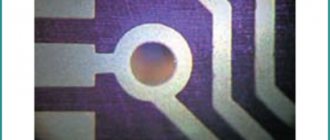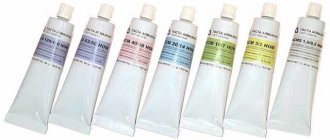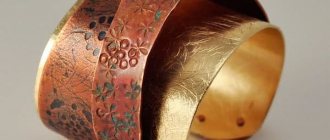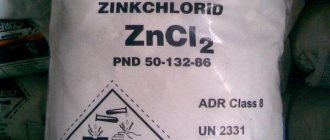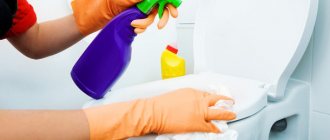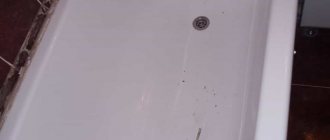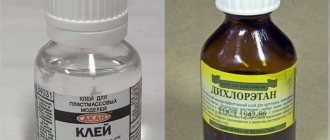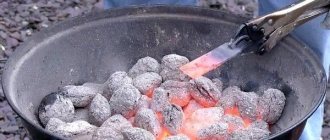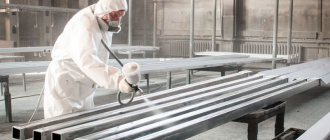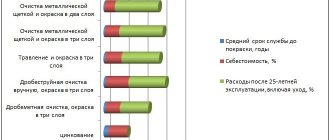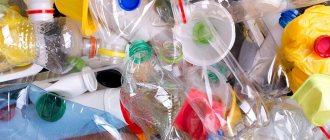Basic rules for caring for copper products
- Copper dishes love cleanliness. Therefore, after each use it must be thoroughly washed and wiped dry.
- Copper should not be cleaned with aggressive substances or brushes. When caring for metal, avoid using products containing abrasive particles and chlorine.
- To avoid scratching the dishes, give preference to wooden, plastic, silicone spoons and spatulas.
- Copper jewelry should be cleaned regularly, especially after wear. A damp cloth will wipe away dust and traces of sweat. Afterwards, wipe dry with a soft cloth.
- Air, sunlight and the proximity of heating devices negatively affect the appearance of copper jewelry. Therefore, it is recommended to store them in a box, wrapping each individually in soft fabric (for example, flannel).
- If you coat copper with metal varnish, the jewelry will retain its attractive appearance for a long time. You just need to update the coating from time to time.
Why do copper products need to be cleaned regularly?
When air and moisture come into contact, a film forms on the surface of the copper. It must be cleaned, because this coating not only spoils the appearance of the product, but can also be unsafe for humans.
Plaque on metal forms for two reasons.
Metal oxidation
When oxygen and copper interact, a chemical reaction occurs that causes the metal to oxidize. At the first stage of oxidation, copper changes its color to purple with a reddish tint. If the deposit is not cleaned off, the oxide will subsequently turn black.
Plaque on a copper product
When copper is left in a humid environment for a long time, a dense green coating forms on the metal - this is the so-called hydroxyl film. Copper hydroxide is poisonous. You cannot eat from dishes that have such a coating. You need to take precautions and remove the film.
Also, copper products may develop a white coating or rust.
Oxidative refining in industry
The copper oxidation operation is carried out after completion of the smelting of the feedstock. The process is carried out by injecting compressed air into the melt through tuyeres. The resulting slag is removed manually from the surface of the melt using a special rake and dumped into a container. The slag contains copper, impurities, lead, tin, etc. The reduction process must be carried out to remove oxygen from the melt and reduce the copper oxides. The operation is performed by injecting natural gas into the melt.
From the furnace, exhaust gases are fed into the gas cleaning system and pass through a dust collector, which captures coarse dust. The collector is equipped with a ventilation pipe in the event of an emergency release of gas into the atmosphere. The fire cleaning furnace operates in continuous mode. The operating cycle of the technological process includes:
- loading of raw materials;
- oxidation, slag formation, reduction;
- loading of refined metal.
The entire subsequent process is called oxidative refining of copper. It cannot be separated from the general purification process, since it is part of the entire method of obtaining pure metal. Once the required parameters have been resolved, the copper melt is used for the next process.
Effective Copper Cleaning Methods
Before using various methods to clean copper, wash the product in warm soapy water or dishwashing liquid. This will help remove minor dirt, dust and add shine. If after the procedure the surface remains unchanged, proceed to cleaning using one of the methods convenient for you.
Copper cookware should not be washed in the dishwasher. It is preferable to wash and clean by hand.
Vinegar with salt
They cope well with thick layers of plaque. To clean, pour 9% vinegar over the plaque and sprinkle with finely ground salt. After 10 minutes, wipe with a cloth and rinse.
Cleaning copper with ammonia
Soak a rag in ammonia and apply it to the copper product. Then wipe with a clean rag to remove the ammonia. For a better effect, chalk chips are added to the alcohol. It mechanically scrubs and absorbs dirt.
Cleaning copper with phosphoric acid
To clean copper from rust, phosphoric acid is used. The product is dipped in a 15–30% solution of orthophosphoric acid and applied with a brush or spray. Leave for a few minutes to take effect. Clean off plaque with a cotton cloth. If necessary, repeat the procedure.
Cleaning with ketchup
This unexpected solution has proven itself in cleaning copper products from black deposits. Apply a generous amount of ketchup or tomato paste to the metal. Leave for an hour and wipe with a cotton rag. The fruit acids contained in tomatoes will not only get rid of plaque, but also restore the brightness of the metal.
Cleaning with salt and lemon
Squeeze the juice of one lemon. Add salt until a paste forms. Using a cloth or toothbrush, clean the surface of the copper to remove any dirt.
Using Baking Soda
Baking soda is one of the popular substances for cleaning metal objects. When cleaning with baking soda, copper products regain their lost shine.
Vegetable oil
Vegetable oil fills microscopic cracks in metal. Thanks to this, the product looks smoother, gaining a natural shine.
Use of chemicals
In addition to regular household cleaning products for cleaning copper, you can purchase specialized preparations at a jewelry store. They are good because they carefully clean the metal without damaging it. Such drugs include Trilon B.
Phosphorous treatment
Refining copper phosphate is phosphorus deoxidized hard copper, which is a durable general purpose resin. It is deoxidized by copper phosphorus, in which the residual phosphorus is kept at a low level (0.005-0.013%) to achieve good electrical conductivity. It has good thermal conductivity and excellent welding and soldering properties. The oxide after refining copper in this manner, remaining in the solid copper resin, is removed by phosphorus, which is the most commonly used deoxidant.
The table shows different indicators from annealed (soft) to hard copper state.
| Tensile strength | 220-385 N/mm2 |
| Tensile strength | 60-325 N/mm2 |
| Elongation | 55-4 % |
| Hardness (HV) | 45-155 |
| Electrical conductivity | 90-98 % |
| Thermal conductivity | 350-365 W/cm |
Lead frames connect wiring to electrical terminals on the surface of the semiconductor and large-scale circuitry on electrical devices and printed circuit boards. The material is selected to meet the requirements of the process and to be reliable during installation and operation.
How to clean copper products until they shine?
The choice of cleaning method depends on the degree of contamination and the type of product that needs to be treated.
Cleaning copper from white deposits
White spots on copper are also formed due to oxidative reactions. They usually appear on products made from alloys of copper and other metals. One of the presented methods will help against this kind of contamination: using ammonia, vinegar with salt or ketchup.
How to clean copper from black and green deposits?
Ammonia can deal with black and green deposits. You can also remove the toxic layer with a mixture of turpentine, oxalic acid and vodka. The ingredients are mixed in equal proportions and the copper products are cleaned with it using a cloth.
Cleaning copper from rust
To renew rusty copper products, use aggressive acids such as hydrochloric acid. Apply acid to a piece of cloth and treat the copper with it. After treatment, rinse thoroughly to remove any remaining aggressive substance.
When working with acids, be sure to wear gloves. And clean only in a well-ventilated area.
How to clean copper oxide?
To remove oxide in the form of a reddish coating, place the product in a 5% ammonia solution or ammonium carbonate. Hold until the plaque begins to come off.
How to clean a copper pot inside and outside?
The outer surface of the Turk can be cleaned using any of the methods presented above.
If you do not have experience working with aggressive chemicals and acids, use accessible and safe methods.
On the inside of the Turks, it is recommended to use softer substances so as not to damage the coating. For example, soda or ketchup.
Mechanical cleaning of copper products
Over time, a layer of dirt adheres to jewelry and various objects with carved patterns, consisting of many parts. You can get rid of it mechanically.
Start by removing surface dirt by washing the jewelry with soapy water. Next, use a needle to remove dirt from small holes and crevices. Then go over the entire product with a toothbrush.
During mechanical cleaning, you can use salt or baking soda, so the effect will be achieved faster.
How to clean tinned copper?
During the tinning process, a thin layer of tin is applied to the inside of copper cookware. Tin is a soft metal and must be cleaned with care.
Do not use sharp objects or harsh abrasives.
To clean a tinned copper product, you need to wash it with dishwashing detergent. Severe dirt is removed point by point with a soft brush or fine steel wool, previously soaked in vegetable oil.
How to clean a copper samovar?
The copper samovar is an antique item. Therefore, it is especially important to preserve its appearance and extend the service life of an antique device.
To clean a copper samovar, take salt, vinegar and flour in equal proportions. The ingredients are mixed and applied with a sponge to the outside of the samovar.
After treating the entire surface, remove any remaining cleaning agent with a dry cotton cloth. To make the surface shiny, wipe it with lemon.
If there are deep stains in the samovar, they can be removed with kerosene. Soak a cloth in the mixture and wipe particularly dirty areas.
How can you clean a brass samovar?
Brass is an alloy of copper and zinc. Aggressive chemicals and abrasives can damage the surface of such a samovar.
For safe cleaning, use oxalic acid. It must be diluted in 1 liter of water, applied to the surface of the samovar and left for 5 minutes for the reaction to occur.
Afterwards, the solution is washed off and the surface is wiped with a sponge soaked in soda solution to neutralize the acid. Rinse the product and wipe dry.
Clean a copper basin at home
As a rule, a copper basin is used to make jam. Such dishes have good thermal conductivity, antiseptic properties, are safe for humans, and when cooking the jam practically does not stick to the walls.
If the jam is still burnt, the copper basin can be cleaned with vinegar dough. For this ancient method, you need to knead the dough by mixing flour and table vinegar. Next, the dough is rolled out thinly and placed on the dirt.
After the mixture dries, carefully remove it. The vinegar paste absorbs dirt, making the surface perfectly clean.
Prevention of green plaque formation
Today, copper purification is an extremely pressing issue, because products made from this alloy can often be found in everyday life.
Copper decorative items can add comfort and beauty to a home, but only if they are completely clean, because if they are darkened or greenish, they can completely spoil the impression.
But don’t despair, because there are many ways to clean copper at home.
Copper is the best for dishes
Before you begin cleaning copper products, you should use personal protective equipment, because almost all of the products used during cleaning can cause serious harm to health.
To ensure personal protection you will need:
- latex gloves;
- plastic glasses;
- means for respiratory protection (cotton-gauze bandage, respirator or honey mask).
Cleaning ancient copper coins with soda
In order to give copper products a shine, they should be wiped with a mixture of vinegar, flour and salt, then polish the surface with a soft cloth, and they will shine like new.
Salt and vinegar solution cleans copper items
If, after cleaning the copper, it is necessary to give it the most marketable appearance, then an artificial patina should be applied to the product.
Before you start, you need to prepare a solution, for this you will need:
- 1 liter of distilled water;
- 50 grams of vitriol (you can buy it at any gardening store);
- 5 grams of potassium permanganate.
After mixing all the components, the solution must be heated, but not brought to a boil, and a suitable object must be lowered into it. The product should be twisted from time to time, after it has received the appropriate color, you can remove it from the solution and dry it properly.
This effect is lost quite quickly, but it can be preserved.
To do this, it is necessary to cover the cleaned surface with a mixture of alcohol and benzene in equal proportions.
This method will help protect any copper product from the harmful effects of the environment and rapid fading.
This is what ancient copper utensils look like
If necessary, you can clean a fairly large piece of home decor from a greenish coating - its entire surface should be rubbed with half a lemon, since its huge size will not allow you to put it in any container.
Afterwards, you need to wait about 5 minutes and rub the surface with a brush, and then rinse with water.
This method is ideal for cleaning copper chandeliers, lamps, and plumbing fixtures at home, because this way you can easily and easily get rid of traces of oxidation on the surface of products.
If you need to clean copper utensils from any contamination, then you should be aware that copper that has turned green or turned greyish can be quite poisonous and therefore you should not eat food from such utensils.
After all, this can cause serious harm to health. So if the dishes are still covered with a greenish coating, then it is better to throw them away as a home decor item.
Cleaning copper utensils is necessary for future use of the product.
But before that you will have to clean it. To do this, you just need to place such dishes in hot water with baking soda added to the detergent, then you need to rub it, and then rinse it in clean water. This method will help you quickly and efficiently clean copper products without much time and effort.
Copper products must be placed in the prepared solution
To clean items made of polished copper, you just need to moisten the surface in kerosene, and then wipe it with chalk powder using a woolen rag.
The cost of kerosene is about 30-50 rubles per liter, so this cleaning can be not only quite effective, but also economical.
You can also wipe a copper object with ammonia (ammonia) and then carefully rinse it under running water; this method will perfectly help remove greenish deposits and blackness.
If you need to clean copper coins or antiques of great value from traces of oxidation, then the process must be very careful so as not to cause harm or scratches.
To do this, place the desired item in a ten percent citric acid solution; it will easily remove the greenish coating and will not cause any harm to the alloy.
To carefully clean copper objects from patina, an extremely unusual method can help: you need to soak the contaminated item in kefir for a couple of hours, then rinse the item in running water. Another and no less unusual option is ketchup.
Kefir and ketchup contain an acid that interacts with the oxide, dissolving it.
Naturally, these methods may not be effective enough for more powerful contaminants, but they will not cause any harm to the iron object.
Cleaning copper coins with kefir may also help
We invite you to familiarize yourself with the pattern of a women's vest: 12 models with descriptions, photos, videos mk || How to sew a long sleeveless vest
Then soak the copper product in this solution for several hours.
This method can extremely carefully clean any iron object, but its main drawback is that all this can take a lot of time, depending on the degree of oxidation, the function must be repeated several times.
All of the methods listed above will help to perfectly clean copper objects from various contaminants, traces of oxide, and plaque at home, without much harm to them.
To prevent oxidation of copper objects, you need to store them in special cases, putting a piece of chalk in there. Copper products should not be exposed to direct sunlight. You also need to store them away from heating devices and radiators.
To prevent green tarnish from appearing on copper jewelry, you should wash and polish it with a cloth after each use. Do not leave items wet; it is better to wipe them dry immediately after washing.
By learning to clean copper from green deposits, you can extend the life of objects and devices. They, in turn, will create coziness in the room, and copper jewelry will delight you with its shine and warm, clean look.
Cleaning Copper Coins
Antique copper coins often have high antique value. Therefore, it is important for every numismatist to know how to clean a coin without damaging it.
Boiling coins in soda solution
Baking soda not only perfectly cleans copper coins, but also makes them shine.
To begin, dissolve 10 tbsp in a saucepan. spoons of soda in 1 liter of water. Dip copper coins into the solution until they are completely covered with liquid. Place the pan on the fire and simmer for 30 minutes.
Let the coins cool and remove any remaining baking soda using a toothbrush.
"Trilon B"
This special chemical mixture can be purchased at jewelry stores. It does not destroy the surface of copper products and carefully cleans them of oxide.
Dip the products into the solution and hold for 10–20 minutes. In case of severe contamination, the procedure can be repeated.
Kefir and vegetable oil
Kefir contains non-aggressive acids that gently cleanse copper. Place coins in fermented milk product for 1 hour. Then rinse with running water and dry.
Vegetable oil also gently cleans coins, filling small cracks and giving them a natural shine. Pour 2 cm of oil into a pan and boil. Using tweezers, lower the coins and boil them for 10-20 minutes. Then rinse the items with dishwashing liquid and dry.
Citric acid and vinegar
Vinegar will help remove dark spots on old coins. Dilute 1.5 tbsp in 500 ml of water. spoons of vinegar (9%) and salt. Dip coins into the liquid and put on fire. Boil for 10 minutes, rinse and dry.
On a note. Instead of vinegar, you can use citric acid or freshly squeezed lemon juice.
Iodide refining of non-ferrous metals
Copper(II) ions oxidize iodide ions to molecular iodine, and in this process are themselves reduced to copper(I) iodide. The original mixed brown mixture separates into an off-white precipitate of copper(I) iodide in iodine solution. This reaction is used to determine the concentration of copper (II) ions in solution. If you add a specified volume of a solution containing copper(II) ions to a flask and then add an excess of potassium iodide solution, you will obtain the reaction described above.
2Cu2+ + 4I- → 2CuI (s) + I2 (aqueous solution)
You can find the amount of iodine released by titrating with sodium thiosulfate solution.
2S2O2-3 (solution) + I2 (solution) → S4O2-6 (aqueous solution) + 2I- (aqueous solution)
When the sodium thiosulfate solution is run from the burette, the color of the iodine disappears. When it's almost all gone, add starch. The entire copper iodide refining reaction will be reversible with iodine to produce a deep blue starch-iodine complex that is much easier to see.
Add the last few drops of sodium thiosulfate solution until the blue color disappears. If you trace the proportions through the two equations, you will find that for every 2 moles of copper(II) ions you had to start with, you need 2 moles of sodium thiosulfate solution. If you know the concentration of the sodium thiosulfate solution, it is easy to calculate the concentration of copper(II) ions. The result of this attempt is to obtain a simple copper(I) compound in solution.
How not to clean copper products
In order to preserve the shine of copper products for a long time and not scratch their surface during cleaning, you must not:
- use abrasive materials and hard metal objects;
- subject to constant exposure to humidity;
- remove the varnish layer, if there is one on the product;
- expose to direct sunlight and heating devices;
- leave copper objects dusty, without carrying out wet cleaning for a long time.
To maintain the attractive appearance of copper products, they need to be cleaned regularly. It is important to remember that over time, copper wears off and objects become thinner. Therefore, do not wait until the dishes and decorations are covered with a thick layer of dirt. After all, small stains are easier to clean using more gentle methods.
